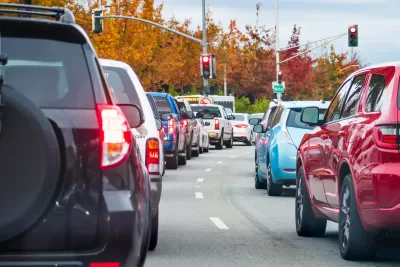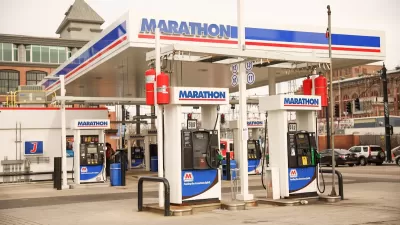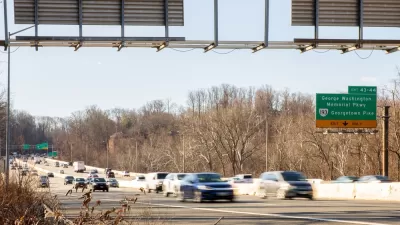A USDOT report calls for a set of strategies including but not limited to electrification of the transportation sector.

A report from the U.S. Department of Transportation highlights the need to reduce driving in addition to adopting electric vehicles to reach decarbonization goals, writes Kea Wilson in Streetsblog USA — “but it's unclear if any level of government is prepared to take the steps necessary to do both,” Wilson adds.
Assuming that no further climate legislation is passed, one study cited in the report found that transport emissions are on track to grow a staggering 23 percent by 2050, rather than falling to net zero, which experts say is necessary to avoid the worst impacts of climate change.
According to the report, no level of government has taken sufficient steps to reduce driving. “The U.S. will not be able to decarbonize the transportation sector by midcentury without addressing increased demand,” the report emphasizes.
The report calls for increasing convenience “by decreasing the distance Americans need to travel to key destinations (and the safety they can expect along the journey), as well as ‘improving efficiency’ by supporting mass transportation and better freight strategies.”
Wilson points out that, despite the report’s findings, USDOT continues to award grants to projects that perpetuate car-centric planning and transportation systems.
FULL STORY: USDOT Warns Congress That Americans Need to Drive Less to Survive Climate Change

Study: Maui’s Plan to Convert Vacation Rentals to Long-Term Housing Could Cause Nearly $1 Billion Economic Loss
The plan would reduce visitor accommodation by 25,% resulting in 1,900 jobs lost.

North Texas Transit Leaders Tout Benefits of TOD for Growing Region
At a summit focused on transit-oriented development, policymakers discussed how North Texas’ expanded light rail system can serve as a tool for economic growth.

Why Should We Subsidize Public Transportation?
Many public transit agencies face financial stress due to rising costs, declining fare revenue, and declining subsidies. Transit advocates must provide a strong business case for increasing public transit funding.

How to Make US Trains Faster
Changes to boarding platforms and a switch to electric trains could improve U.S. passenger rail service without the added cost of high-speed rail.

Columbia’s Revitalized ‘Loop’ Is a Hub for Local Entrepreneurs
A focus on small businesses is helping a commercial corridor in Columbia, Missouri thrive.

Invasive Insect Threatens Minnesota’s Ash Forests
The Emerald Ash Borer is a rapidly spreading invasive pest threatening Minnesota’s ash trees, and homeowners are encouraged to plant diverse replacement species, avoid moving ash firewood, and monitor for signs of infestation.
Urban Design for Planners 1: Software Tools
This six-course series explores essential urban design concepts using open source software and equips planners with the tools they need to participate fully in the urban design process.
Planning for Universal Design
Learn the tools for implementing Universal Design in planning regulations.
Ascent Environmental
Borough of Carlisle
Institute for Housing and Urban Development Studies (IHS)
City of Grandview
Harvard GSD Executive Education
Toledo-Lucas County Plan Commissions
Salt Lake City
NYU Wagner Graduate School of Public Service





























